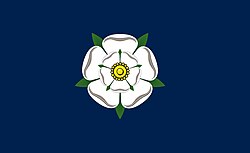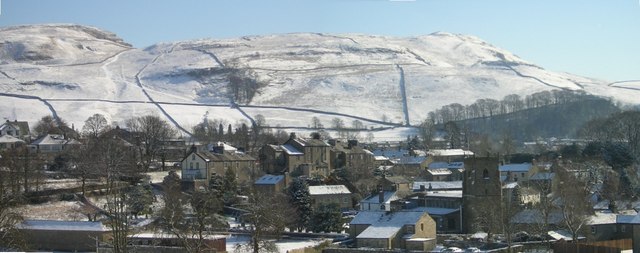Portal:Yorkshire
The Yorkshire Portal
Yorkshire (/ˈjɔːrkʃər, -ʃɪər/ YORK-shər, -sheer) is an area of Northern England which was historically a county. Despite no longer being used for administration, Yorkshire retains a strong regional identity. The county was named after its original county town, the city of York.
The south-west of Yorkshire is densely populated, and includes the cities of Leeds, Sheffield, Bradford, and Wakefield. The north and east of the county are more sparsely populated, however the north east includes the southern part of the Teesside conurbation, and the port city of Kingston upon Hull is located in the south-east. York is located near the centre of the county. Yorkshire has a coastline to the North Sea to the east. The North York Moors occupy the north east of the county, and the centre contains the Vale of Mowbray in the north and the Vale of York in the south. The west contains part of the Pennines, which form the Yorkshire Dales in the north-west. (Full article...)
Selected article

Gisborough Priory is a ruined Augustinian priory in Guisborough in the borough of Redcar and Cleveland and ceremonial county of North Yorkshire, England. It was founded in 1119 as the Priory of St Mary by Robert de Brus, 1st Lord of Annandale, an ancestor of the Scottish king, Robert the Bruce. It became one of the richest monastic foundations in England with grants from the crown and bequests from de Brus, other nobles and gentry and local people of more modest means. Much of the Romanesque Norman priory was destroyed in a fire in 1289. It was rebuilt in the Gothic style on a grander scale over the following century. Its remains are regarded as among the finest surviving examples of early Gothic architecture in England.
The priory prospered until the Dissolution of the Monasteries in 1540, when it was abolished along with England's other monastic communities. The priory buildings were demolished and the stone re-used in other buildings in Guisborough. The east end of the priory church was left standing with its great window forming a distinctive arch, a well-known landmark used as a symbol for Guisborough. It became part of the estate of the Chaloner family, who acquired it in 1550. The east window was preserved by them as part of a Romantic vista adjoining their seat, Gisborough Hall, from which the priory takes its idiosyncratically spelled name. It is owned by the Chaloners but is in the care of English Heritage as a scheduled monument. (read more . . . )
Selected image

Credit: Kyle McInnes
Skidby Windmill is a Grade II listed working windmill at Skidby near Beverley, in the East Riding of Yorkshire. Originally built in 1821, the mill was further extended to its current 5 stories in 1870. (read more . . . )
Selected biography

Edwin was the son of Ælle king of Deira. His sister Acha was married to Æthelfrith, king of neighbouring Bernicia. An otherwise unknown sibling fathered Hereric, who in turn fathered Abbess Hilda of Whitby and Hereswith, wife to king Anna of East Anglia's brother Æthelric. With the death of Æthelfrith, and of the powerful Æthelberht of Kent the same year, Raedwald and his client Edwin were well placed to dominate England, and indeed Raedwald did so until his death a decade later. Edwin annexed the minor British kingdom of Elmet following a campaign in either 616 or 626. Elmet had probably been subject to Mercia and then to Edwin. The much larger kingdom of Lindsey appears to have been taken over c. 625, after the death of king Raedwald. (read more . . . )
Selected list -

The Churches Conservation Trust, which was initially known as the Redundant Churches Fund, is a charity whose purpose is to protect historic churches at risk, those that have been made redundant by the Church of England. The Trust was established by the Pastoral Measure of 1968. The legally defined object of the Trust is "the preservation, in the interests of the nation and the Church of England, of churches and parts of churches of historic and archaeological interest or architectural quality vested in the Fund ... together with their contents so vested".
The Trust cares for over 350 churches. The charity is financed partly by the Department for Culture, Media and Sport and the Church Commissioners, but grants from those bodies were frozen in 2001, since when additional funding has come from other sources, including the general public. During the 2016-2017 period, the Trust's income was £9,184,283 and expenditures totaled £9,189,061; 92% of the latter was spent on front line projects. During that year it had 64 employees, and received the support of up to 2,000 volunteers. The charity is run by a board of trustees, who delegate the day-to-day management to a chief executive and his senior management team. (Full article...)List of selected lists
|
|---|
Selected Did You Know . . .

- ...that the Yorkshire Museum (pictured) paid £2.5 million pounds for an item found in Yorkshire using a metal detector?
- ...that Bradford City Football Club blamed their FA Cup exit in the 1919–20 season on a pre-game trip to Fry's chocolate works?
- ...that the charitable Sheffield Town Trust funded a cricket match which aimed to "prevent the infamous practice of throwing at cocks"?
- ... that when three men wearing gloves, masks and balaclavas were found on the roof of a church missing £100,000 worth of lead, they were let off because police said they "might be there just for the view"?
General images -
Subcategories
Selected panorama
Topics
Related portals
WikiProjects
Things you can do
Associated Wikimedia
The following Wikimedia Foundation sister projects provide more on this subject:
-
Commons
Free media repository -
Wikibooks
Free textbooks and manuals -
Wikidata
Free knowledge base -
Wikinews
Free-content news -
Wikiquote
Collection of quotations -
Wikisource
Free-content library -
Wikiversity
Free learning tools -
Wikivoyage
Free travel guide -
Wiktionary
Dictionary and thesaurus
- Manually maintained portal pages from June 2018
- All manually maintained portal pages
- Portals with triaged subpages from June 2018
- All portals with triaged subpages
- All portals
- Portals with named maintainer
- Yorkshire portal
- Random portal component with 21–25 available subpages
- Random portal component with 11–15 available image subpages
- Random portal component with 16–20 available subpages
- Random portal component with 11–15 available subpages
- United Kingdom portals
- WikiProject Yorkshire
- Portals needing placement of incoming links



















































